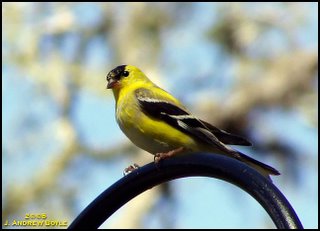Got an email before I was about to head out to get the boys from school. It was from Ellen Rocco, fellow birder and Orange Audubon board member. Seems she found a goose out near the airport and wondered if I could verify the species and report to the bird list.
Doesn't she know I HATE that kind of thing? Finding birds and such? Bah!
So, 15 minutes later, the boys and I found the park in questions and, lo and behold, there it was: a dark-morph Snow Goose!
I got out of the car slowly as not to spook the bird. However, that was not necessary. The goose was swimming toward us...
Still, I was snapping photos as I approached the pond just in case.
2-3 shots with the Pentax, 2-3 with the digital, switch and repeat,
switch and repeat.
It flew away from us by the time we got to the edge of the sidewalk but I sat down in the grass and after it landed it turned and swam right back. The boys were, well, being boys running behind me and getting a little noisy. I stopped short of asking them to chill when the goose seemed to be heading toward them despite the din and general running about.
This bird was very unafraid of us the rest of the time. At one point I actually yelled, "Hey, back up! You are too close for a picture!". The boys laughed. The goose got closer. As far as we can figure out, folks must have started feeding this goose when it arrived one day and now it kind of expects it.
The dark-morph Snow Goose used to be considered a separate species of goose. Use to be called the Blue Goose but has since been linked as a sub-species to the all white Snow Goose. Closest they USUALLY get to here is over on the Atlantic Coast in secluded locations.
So many times I have been disappointed by reports of Snow Geese over at Merritt Island which typically include closing lines such as, "The geese are in a restricted area..."
Now, yet another Lifer stops over in my neighborhood!
You can find more shots of this friendly, wayward goose right about...here.
